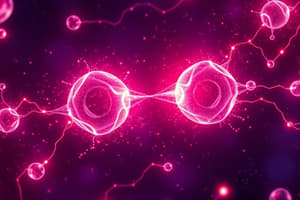Podcast
Questions and Answers
What type of bond is formed by the head-on overlap of two orbitals?
What type of bond is formed by the head-on overlap of two orbitals?
- Lambda bond
- Delta bond
- Sigma bond (correct)
- Pi bond
Which of the following statements correctly describes the nature of ionic compounds?
Which of the following statements correctly describes the nature of ionic compounds?
- Have low melting and boiling points
- Contain individual molecules
- Usually soft and flexible
- Conduct electricity when dissolved in water (correct)
According to the VSEPR theory, what determines the shape of a molecule?
According to the VSEPR theory, what determines the shape of a molecule?
- The number of lone pairs and bond pairs around the central atom (correct)
- The total number of atoms
- The atomic mass of the central atom
- The type of bonds present in the molecule
Which type of molecule usually has low melting and boiling points?
Which type of molecule usually has low melting and boiling points?
How many total bond pairs are involved in a triple bond?
How many total bond pairs are involved in a triple bond?
What is the valency of oxygen based on its ability to combine with hydrogen atoms?
What is the valency of oxygen based on its ability to combine with hydrogen atoms?
In a nitrogen molecule, what type of overlap occurs to form the pi bonds?
In a nitrogen molecule, what type of overlap occurs to form the pi bonds?
What characteristic of covalent compounds differentiates them from ionic compounds?
What characteristic of covalent compounds differentiates them from ionic compounds?
Which of the following statements accurately describes the electronegativity difference of a polar covalent bond?
Which of the following statements accurately describes the electronegativity difference of a polar covalent bond?
What type of bonding is indicated by an electronegativity difference of 2.5?
What type of bonding is indicated by an electronegativity difference of 2.5?
Why does water dissolve ionic compounds like sodium chloride?
Why does water dissolve ionic compounds like sodium chloride?
Which molecule would you predict has a non-polar covalent bond?
Which molecule would you predict has a non-polar covalent bond?
What experimental result would indicate that a liquid is non-polar?
What experimental result would indicate that a liquid is non-polar?
What type of covalent bond is formed when atoms share electrons equally?
What type of covalent bond is formed when atoms share electrons equally?
What is the electronegativity difference that typically indicates a covalent bond?
What is the electronegativity difference that typically indicates a covalent bond?
Which shape corresponds to a molecule with 3 bond pairs and 1 lone pair?
Which shape corresponds to a molecule with 3 bond pairs and 1 lone pair?
How does water's polar nature affect its role as a solvent?
How does water's polar nature affect its role as a solvent?
What is the bond angle associated with a tetrahedral shape?
What is the bond angle associated with a tetrahedral shape?
What is the key characteristic of intramolecular bonding?
What is the key characteristic of intramolecular bonding?
How does electronegativity influence polar covalent bonds?
How does electronegativity influence polar covalent bonds?
Which of the following would most likely form a non-polar covalent bond?
Which of the following would most likely form a non-polar covalent bond?
What is the primary factor that determines the polarity of covalent bonds?
What is the primary factor that determines the polarity of covalent bonds?
Which shape is associated with 2 bond pairs and 2 lone pairs?
Which shape is associated with 2 bond pairs and 2 lone pairs?
What does a higher electronegativity difference indicate about a bond?
What does a higher electronegativity difference indicate about a bond?
Flashcards
Valency
Valency
The number of hydrogen or monovalent atoms an element combines with.
Sigma Bond
Sigma Bond
A bond formed by head-on overlap of atomic orbitals.
Pi Bond
Pi Bond
A bond formed by sideways overlap of p orbitals.
Covalent Bond
Covalent Bond
Signup and view all the flashcards
Lone Pair
Lone Pair
Signup and view all the flashcards
VSEPR Theory
VSEPR Theory
Signup and view all the flashcards
Octet Rule
Octet Rule
Signup and view all the flashcards
Ionic Compound Properties
Ionic Compound Properties
Signup and view all the flashcards
Polar Covalent Bond
Polar Covalent Bond
Signup and view all the flashcards
Non-Polar Covalent Bond
Non-Polar Covalent Bond
Signup and view all the flashcards
Electronegativity Difference (EN diff.)
Electronegativity Difference (EN diff.)
Signup and view all the flashcards
Ionic Bond
Ionic Bond
Signup and view all the flashcards
Water's Polarity
Water's Polarity
Signup and view all the flashcards
Water as a Solvent
Water as a Solvent
Signup and view all the flashcards
Intramolecular Bonding
Intramolecular Bonding
Signup and view all the flashcards
Intermolecular Bonding
Intermolecular Bonding
Signup and view all the flashcards
VSEPR Theory
VSEPR Theory
Signup and view all the flashcards
Molecular Shape
Molecular Shape
Signup and view all the flashcards
Electronegativity
Electronegativity
Signup and view all the flashcards
Polar Covalent Bond
Polar Covalent Bond
Signup and view all the flashcards
Non-polar Covalent Bond
Non-polar Covalent Bond
Signup and view all the flashcards
Electronegativity Difference
Electronegativity Difference
Signup and view all the flashcards
VSEPR Table
VSEPR Table
Signup and view all the flashcards
Molecular Shape Prediction
Molecular Shape Prediction
Signup and view all the flashcards
Study Notes
Chemical Bonding
- A compound is a substance formed by two or more different elements combined chemically.
- Atoms combine to form compounds through attractive forces called chemical bonds.
- Octet Rule: Atoms tend to gain, lose, or share electrons to achieve a stable electron arrangement with eight electrons in their outermost energy level, like noble gases.
- Exceptions: Transition metals, hydrogen, lithium, and beryllium do not always follow the octet rule.
- Ion: A charged atom or group of atoms. Forming cations (positive) by losing electrons and anions (negative) by gaining electrons.
Ionic Bonding
- Definition: An ionic bond is the force of attraction between oppositely charged ions in a compound.
- Formation: Complete transfer of electrons from one atom to another.
- Metals of groups I and II tend to lose electrons, while non-metals of groups VI and VII tend to gain electrons.
- Ionic compounds are neutral, meaning the total positive charges equal the total negative charges.
Writing Formulas of Ionic Compounds
- Formula: Uses symbols to represent present atoms and numbers to show how many atoms of each element are present.
- Metals in groups I & II, with non-metals in groups VI & VII often form ionic compounds.
- Examples of polyatomic anions include: hydroxide, nitrate, hydrogen carbonate, permanganate, carbonate, chromate, dichromate, sulfate, sulfite, thiosulfate, phosphate, and ammonium.
- To write a formula, balance the positive and negative charges.
Covalent Bonding
- Definition: A molecule is a group of atoms joined together, capable of independent existence. Covalent bonds involve the sharing of electrons between atoms.
- Formation: Shared electron pairs hold atoms to together. Atoms share electrons to obtain a stable electron configuration.
- Sigma bond: Formed by head-on overlap of atomic orbitals.
- Pi bond: Formed by sideways overlap of atomic orbitals.
- Single bond = 1 sigma
- Double bond = 1 sigma, 1 pi
- Triple bond = 1 sigma, 2 pi
- Examples: Hydrogen molecules, chlorine molecules, and water molecules.
Properties of Ionic and Covalent Compounds
- Ionic Compounds: High melting/boiling points, usually solids at room temperature, hard and brittle, conduct electricity when molten or dissolved in water.
- Covalent Compounds: Low melting and boiling points, usually liquids or gases at room temperature, soft often, not conduct electricity.
Electronegativity
- Definition: Electronegativity is an atom's ability to attract shared electrons in a covalent bond.
- Polar Covalent Bond: Unequal sharing of electrons, causing one end of the bond to be slightly positive (σ+) and the other slightly negative (σ-).
- Non-polar Covalent Bond: Equal sharing of electrons.
- Predicting Polarity: Larger electronegativity difference usually means a more polar bond.
Intermolecular Forces
- Intramolecular forces: Hold atoms together within a molecule (covalent or ionic bonds).
- Intermolecular forces: Forces of attraction between molecules. Weak forces compared to intramolecular forces.
- Van der Waals forces: Weak attractive forces between non-polar molecules. Temporary dipoles arise from shifting electron distributions.
- Dipole-dipole forces: Attractive forces between polar molecules.
- Hydrogen bonds: Strong dipole-dipole forces between molecules when hydrogen is bonded to nitrogen, oxygen, or fluorine.
Chemical Equilibrium
- Definition: Chemical equilibrium is a dynamic state in a reversible reaction where the rates of the forward and reverse reactions are equal.
- Le Chatelier's Principle: If a stress is applied to a system at equilibrium, the system shifts to relieve the stress. The stress can include changes in concentration, pressure, or temperature.
- Equilibrium Constant (K): A constant that relates the concentrations of reactants and products at equilibrium.
Studying That Suits You
Use AI to generate personalized quizzes and flashcards to suit your learning preferences.




